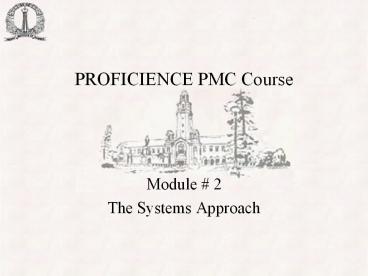IISc MG 286 Project Management Systems Approach - PowerPoint PPT Presentation
Title:
IISc MG 286 Project Management Systems Approach
Description:
This ppts describes the Systems Approach to Project Management, as taught by Prof Parameshwar P. Iyer at the Indian Institute of Science, Bangalore – PowerPoint PPT presentation
Number of Views:97
Title: IISc MG 286 Project Management Systems Approach
1
PROFICIENCE PMC Course
- Module 2
- The Systems Approach
2
Some Basic Concepts/ Definitions
- What is system?
- It is a set of parts (components), which are
coordinated to accomplish (achieve) a set of
goals (objectives). - What is the systems approach?
- It is a wholistic approach to problem solving
that involves formal consideration of - Total system objectives Performance measures
- System environment Fixed constraints
- System resources Inputs
- System components Activities, goals,
performance - System management Component interactions
3
Systems Approach (Contd.)
- Total system objectives (performance measures of
the whole system). - System environment (fixed constraints).
- System resources (inputs).
- System components (their activities, goals, and
performance measures), and - System management (control).
4
A General Systems Model
- Inputs can be purposeful or environmental . Again
, purposeful inputs can be controllable or
uncontrollable . - Outputs can be desired or undesired outputs.
- Design parameters are features or attributes of
the system that will affect system behavior .
5
A General Systems Model
- Constraints establish quantitative limits on each
input , output , and design parameter . - Criteria for evaluation are used to establish
relative goodness amongst several alternative
designs or solutions . - Functional representation can be as follow Y( t)
f X (t) , E (t) where t is any independent
variable (time).
6
Areas of Systems Studies
1. System design Given X(t), Y(t), E(t)
Determine f 2. System Analysis Given X(t), f,
E(t) Determine Y(t) 3. System Control Given f,
Y(t), E(t) Determine X(t)
7
Types of Systems
- Discrete event Vs Continuous flow
- Discrete time (difference equation) Vs Continuous
time (differential equation) - Deterministic Vs Stochastic
- Fixed or static Vs Time variant or dynamic
- Linear Vs Non-linear
- X1(t)-y1(t) X2(t)-y2(t)
- Then, aX1(t)bX2(t)---aY1(t)bY2(t)
8
A Project as a System The life cycle concept
1) A project has sub-projects/work packages like
a system has sub-systems/components 2) The
sub-projects/sub-systems are inter-linked/inter-re
lated 3) We focus on overall project/system
objectives 4) Project identification is similar
to system boundary demarcation 5) Project
resources are like system inputs 6) Like the
system life cycle, a project also has a life
cycle. Major difference A system generally
implies an infinite lifetime (perhaps with
upgrading),while a project is purely temporary.
9
Fig 2.7 A Simple Technological innovation
chain Fig 2.8 Activity Level Fig 2.9 Investment
and return Fig 2.10 A Systems design
algorithm Fig 2.11 A feasibility study algorithm
10
System Identification (Constrained Parametric
Analysis)
Parameter Sub-parameter Constraint Ourput Des
ired Greater Than Undesired L
ess Than Input Controllable
Greater Less Than Uncontrollable
Greater Less Than Environmenta
l Greater Less Than Design Size Greater
Less Than Capacity Greater Less
Than Finance Less Than Economy Less
Than Life Greater Than Evaluation Return/
Profit Greater Than Efficiency Greater
Than Volume Greater Than Oppurtunity Gr
eater Than
11
A Systems Design Algorithm
- Primative Need gtFeasibility Study
- Set of Feasible Solns. gtPrelimin.Design
- Optimal Design gtComparitive Analysis of
Particular Concepts - Optimal System Design gtDetailedDesign
- Complete Description gtPlanning for
Implementation - Production gtUse of Design
12
A Feasibility Study Algorithm
- Primative Need gtgtgt Needs Analysis
- Identified Needs gtgtgt System Identification
- Detailed Problem gtgtgtSynthesis of Solution
Statement - Possible Solutions gtgtgtRealisability and
Practicability - Analysis gtgtgt Set of Feasible
Solutions
13
Data Definition/Technology Factors
- Production Factors
- Time to install
- Degree of disruption
- Learning curve
- Facility/Equipment required
- Development time and cost
- Quality impacts
14
Data Definition/Technology Factors
- Market Factors (For Sellers)
- Size of present and potential future markets
- Probable market share
- Time to acquire market share
- Impact on product/process lines
- Consumer (buyer) acceptance
- Technology life (up gradation)
- Spin off technologies
15
Data Definition/Technology Factors
- Financial Factors
- Profitability
- Net present value of investment
- Pay back period
- Impact on cash flows
- Capital requirements
- Break even (volume/time)
- Start-up/Switch over costs
- Risk levels
16
Data Definition/Technology Factors
- Personnel Factors
- Training requirements
- Skill requirements
- Skill availability
- Resistance to new technologies
- Effect on employment
- Other worker reactions
17
Feasibility of Solutions
Technological feasibility Financial
feasibility Economic practicability User (Social)
acceptability Market (political) viability































